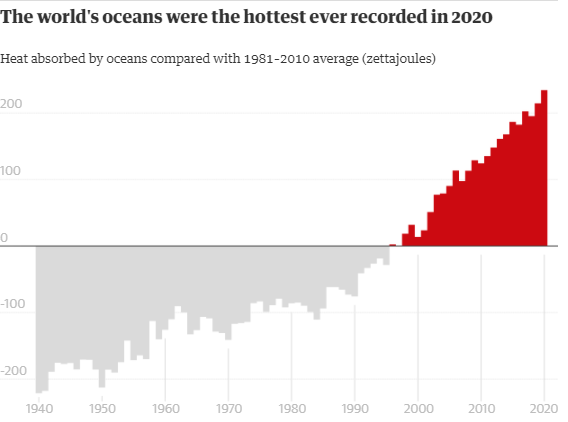Damian Carrington
Environment editor
Study reinforces the hard evidence that carbon emissions are the main cause of worsening extreme weather
A damaged railway bridge five weeks after the flooding of the River Ahr in Rech in the Ahrweiler district of Germany on 19 August. Photograph: Friedemann Vogel/EPA
The record-shattering rainfall that caused deadly flooding across Germany and Belgium in July was made up to nine times more likely by the climate crisis, according to research.
The study also showed that human-caused global heating has made downpours in the region up to 20% heavier. The work reinforces the findings of the Intergovernmental Panel on Climate Change’s landmark report this month that there is “unequivocal” evidence that greenhouse gas emissions from human activities are the main cause of worsening extreme weather.
In recent months there has been devastating flooding in western Europe and China, extreme heatwaves in north-west America and forest fires in Russia, Greece, Turkey and the US.
The scientists from the World Weather Attribution group said that as temperatures rise further, western and central Europe will be exposed to increasing extreme rainfall and flooding. The group previously found that the recent “heat dome” in North America would have been almost impossible without climate change and that the heatwave in Siberia in 2020 and the 2019-20 Australian bushfires were also made more likely by global heating.
“The huge human and economic costs of these floods are a stark reminder that countries around the world need to prepare for more extreme weather events, and that we urgently need to reduce greenhouse gas emissions to avoid such risks from getting even further out of hand,” said Prof Maarten van Aalst at the University of Twente, in the Netherlands, who is also director of the Red Cross Red Crescent Climate Centre. The flooding in Germany and Belgium killed at least 222 people and caused huge damage.
The new study, conducted by Van Aalst and 38 other scientists, used meteorological measurements, high resolution computer models and peer-reviewed research methods. It compared the frequency of extreme rainfall like that behind the flooding in Germany, Belgium and the Netherlands in today’s heated climate with the frequency expected in a world where there had been no human-caused climate change.
It found the climate crisis has made the extreme rainfall between 1.2 and nine times more likely to happen and that such downpours in the region are now 3% to 19% more intense. The hotter air resulting from global heating is able to hold 7% more water vapour per 1C rise. The range in increased likelihood is owing to the variety of climate models used, but the scientists are confident global heating had an impact.
Residents clear debris after heavy flooding of the River Erft caused severe destruction in the village of Bad Münstereifel, Euskirchen district, Germany on 20 July. Photograph: Sascha Steinbach/EPA
The study focused on the region around two areas that were particularly badly affected: the German districts by the Ahr and Erft rivers, where 93mm (3.66 inches) of rain fell in a day, and the Belgian Meuse region, where 106mm fell over two days. The scientists were unable to analyse river levels partly because some hydrological measurement stations were destroyed by the floods.
The peak volume of water on the Ahr was equivalent to the upper reaches of the Rhine, said Enno Nilson at the German Federal Institute of Hydrology: “We had a huge river rushing into a small valley.” The researchers estimated the probability of such extreme rainfall in one location as 0.25% in any one year. “It is a rare event, but a rare event we should increasingly be prepared for,” said Van Aalst.
“These floods have shown us that even developed countries are not safe from the severe impacts of extreme weather that we have seen and that are known to get worse with climate change,” said Friederike Otto at Oxford University. “This is an urgent global challenge and we need to step up to it. The science is clear and has been for years.”
Prof Hayley Fowler at Newcastle University said that, as well as cutting emissions, emergency warning systems and the resilience of infrastructure must be improved to reduce casualties and costs.
Other research in July found that catastrophic floods in Europe could become much more frequent as a result of global heating. It used high-resolution computer models to estimate for the first time that slow-moving storms could become 14 times more common over land by the end of the century in a worst-case scenario. The slower a storm moves, the more rain it dumps on a small area and the greater the risk of serious flooding.






































